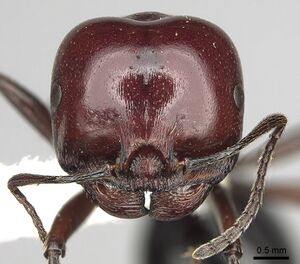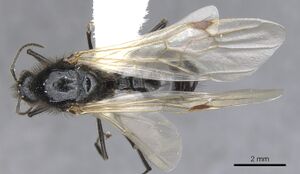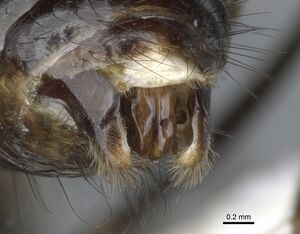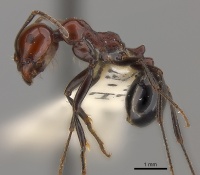Messor angularis
| Messor angularis | |
|---|---|

| |
| Scientific classification | |
| Kingdom: | Animalia |
| Phylum: | Arthropoda |
| Class: | Insecta |
| Order: | Hymenoptera |
| Family: | Formicidae |
| Subfamily: | Myrmicinae |
| Tribe: | Stenammini |
| Genus: | Messor |
| Species: | M. angularis |
| Binomial name | |
| Messor angularis Santschi, 1928 | |
Identification
Bolton (1982) - One of the four sub-Saharan African species which lacks hairs on most or all of the first gastral tergite, angularis is at present known only from Kenya. The most closely related species is the extremely widespread Messor galla which also occurs in Kenya. The two are separated as follows.
angularis Propodeal dorsum without hairs. Occipital margin on each side of the median impression without projecting hairs. Ventral surface of hind femora without freely projecting hairs or at most with 1-2 close to the trochanter. Ventral surface of postpetiole in profile without an anterior prominence or at most with a feeble angle, the surface immediately behind this smoothly concave. Median strip of head dorsally un sculptured or at most with very feeble rugulae anteriorly.
galla Propodeal dorsum with one or more pairs of hairs. Occipital margin on each side of the median impression with one or more pairs of projecting hairs. Ventral surface of hind femora with numerous freely projecting hairs which usually occur over the length of the shaft but which are often densest proximally. Ventral surface of postpetiole in profile with a sharp dentiform or angular prominence anteriorly, the surface immediately behind this irregular, not smoothly concave. Median strip of head dorsally usually conspicuously rugulose, only very rarely reduced.
Keys including this Species
Distribution
Latitudinal Distribution Pattern
Latitudinal Range: -2.75° to -3.5°.
| North Temperate |
North Subtropical |
Tropical | South Subtropical |
South Temperate |
- Source: AntMaps
Distribution based on Regional Taxon Lists
Afrotropical Region: Kenya (type locality).
Distribution based on AntMaps
Distribution based on AntWeb specimens
Check data from AntWeb
Countries Occupied
| Number of countries occupied by this species based on AntWiki Regional Taxon Lists. In general, fewer countries occupied indicates a narrower range, while more countries indicates a more widespread species. |

|
Estimated Abundance
| Relative abundance based on number of AntMaps records per species (this species within the purple bar). Fewer records (to the left) indicates a less abundant/encountered species while more records (to the right) indicates more abundant/encountered species. |

|
Biology
Castes
Worker
Images from AntWeb
   
| |
| Worker. Specimen code casent0217539. Photographer Shannon Hartman, uploaded by California Academy of Sciences. | Owned by CAS, San Francisco, CA, USA. |
Male
Images from AntWeb
     
| |
| Male (alate). Specimen code casent0903657. Photographer Will Ericson, uploaded by California Academy of Sciences. | Owned by NHMUK, London, UK. |
Nomenclature
The following information is derived from Barry Bolton's Online Catalogue of the Ants of the World.
- angularis. Messor galla var. angularis Santschi, 1928f: 202.
- Type-material: 6 syntype worker.
- Type-locality: Kenya (“Afrique orientale anglaise”): Naivasha, 1900 m., st. no. 14, xii.1911(Ch. Alluaud & R. Jeannel).
- Type-depository: NHMB.
- [First available use of Messor barbarus st. semirufus var. angularis Santschi, 1914b: 75 (w.) KENYA; unavailable (infrasubspecific) name.]
- As unavailable (infrasubspecific) name: Emery, 1921f: 72; Emery, 1922c: 97; Wheeler, W.M. 1922a: 803.
- Status as species: Bolton, 1982: 344 (redescription); Bolton, 1995b: 252; Hita Garcia, et al. 2013: 212.
- Distribution: Kenya.
Unless otherwise noted the text for the remainder of this section is reported from the publication that includes the original description.
Description
Worker
Bolton (1982) - Medium to large. HW 2.00- > 2.75.
Anterior clypeal margin flattened to weakly and quite broadly indented medially. With the head in full-face view the occipital margin indented medially, the indentation becoming more distinct with increased size. In HW range 2.00-2.80 the maximum diameter of the eye is 0.42-0.52, about 0.18-0.21 x HW, and the CI range is 104-113. Propodeum unarmed, rounded to right-angled where dorsum meets declivity and sometimes with a reinforcing ridge or flange following the curve, especially in largest workers. Dorsum of head with sculpture very reduced, sometimes without sculpture. Usually with a few very feeble low longitudinal rugulae between the frontal lobes which may extend for a short distance behind them. On each side of this median area, moving outwards towards the eyes and occipital corners, the head is unsculptured except for a very feeble superficial reticular pattern and a few scattered faint punctulae. Pronotum and mesonotum dorsally un sculptured to feebly densely punctulate, generally with some weak transverse rugulae immediately behind the cervical shield. Rarely these are absent but in some they extend further back on the pronotum than is usual. Propodeal dorsum transversely rugose, conspicuously more strongly sculptured than the pronotum or mesonotum. First gastral tergite unsculptured and smooth, usually with a faint superficial reticular pattern visible. Head dorsally with very reduced pilosity; apart from the strong mouthpart hairs and those around the frontal lobes the dorsum with only 2-3 pairs, spanning the midline of the head. With the head in full-face view the sides both in front of and behind the eyes, the occipital corners and the occipital margin without projecting hairs except mid-occipitally where the posteriormost dorsal pair may project on each side of the occipital impression. Psammophore strong, the J-shaped hairs very long and onspicuous. Pronotum dorsally with 0-3 pairs of hairs, when present situated posteriorly, close to the promesonotal junction. Mesonotum with 0-5 pairs of hairs. Some of this variation may be due to abrasion, the mesonotal hairs in particular seem easily lost. Propodeum always hairless dorsally. Petiole with 0-1, postpetiole with 0-2 pairs of hairs respectively. First gastral tergite hairless or at most with a sparse transverse row at the extreme apex of the sclerite. Colour variable, usually with reddish head and alitrunk and black gaster, but the alitrunk often with some black, the amount of which varies from sample to sample. In extreme cases the entire body black but even here the head with a reddish tint showing through.
References
- Bolton, B. 1982. Afrotropical species of the myrmecine ant genera Cardiocondyla, Leptothorax, Melissotarsus, Messor and Cataulacus (Formicidae). Bulletin of the British Museum (Natural History). Entomology, 46: 307-370. (page 344, Raised to species)
- Plowes, N.J.R., Johnson, R.A., Holldobler, B. 2013. Foraging behavior in the ant genus Messor (Hymenoptera: Formicidae: Myrmicinae). Myrmecological News 18, 33-49.
- Santschi, F. 1914b. Voyage de Ch. Alluaud et R. Jeannel en Afrique Orientale, 1911-1912. Résultats scientifiques. Insectes Hyménoptères. II. Formicidae. Paris: Libr. A. Schulz, pp. 41-148. (page 75, First available use of Messor barbarus st. semirufus var. angularis; unavailable name)
- Santschi, F. 1928f. Descriptions de nouvelles fourmis éthiopiennes (suite). Rev. Zool. Bot. Afr. 16: 191-213 (page 202, worker described)
References based on Global Ant Biodiversity Informatics
- Bolton B. 1982. Afrotropical species of the myrmicine ant genera Cardiocondyla, Leptothorax, Melissotarsus, Messor and Cataulacus (Formicidae). Bulletin of the British Museum (Natural History). Entomology 45: 307-370.
- Garcia F.H., Wiesel E. and Fischer G. 2013.The Ants of Kenya (Hymenoptera: Formicidae)Faunal Overview, First Species Checklist, Bibliography, Accounts for All Genera, and Discussion on Taxonomy and Zoogeography. Journal of East African Natural History, 101(2): 127-222
- IZIKO South Africa Museum Collection

